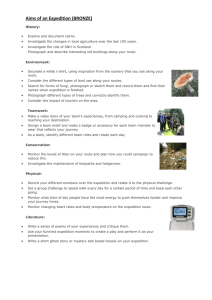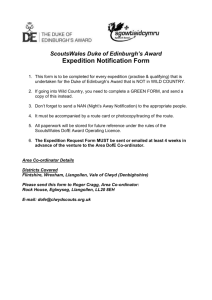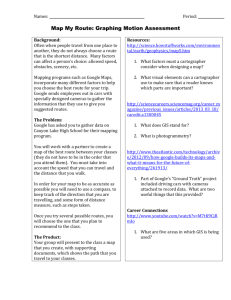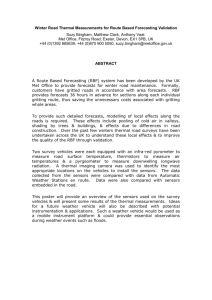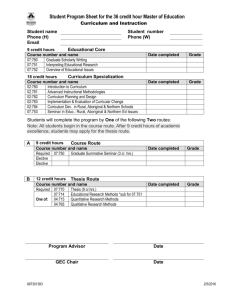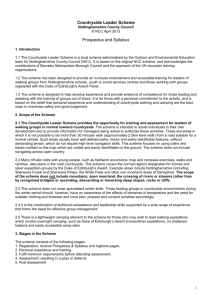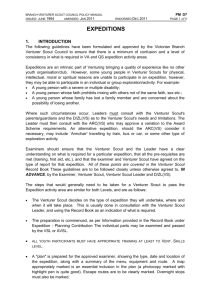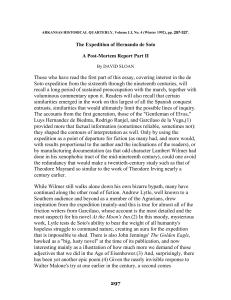here - bxm expeditions
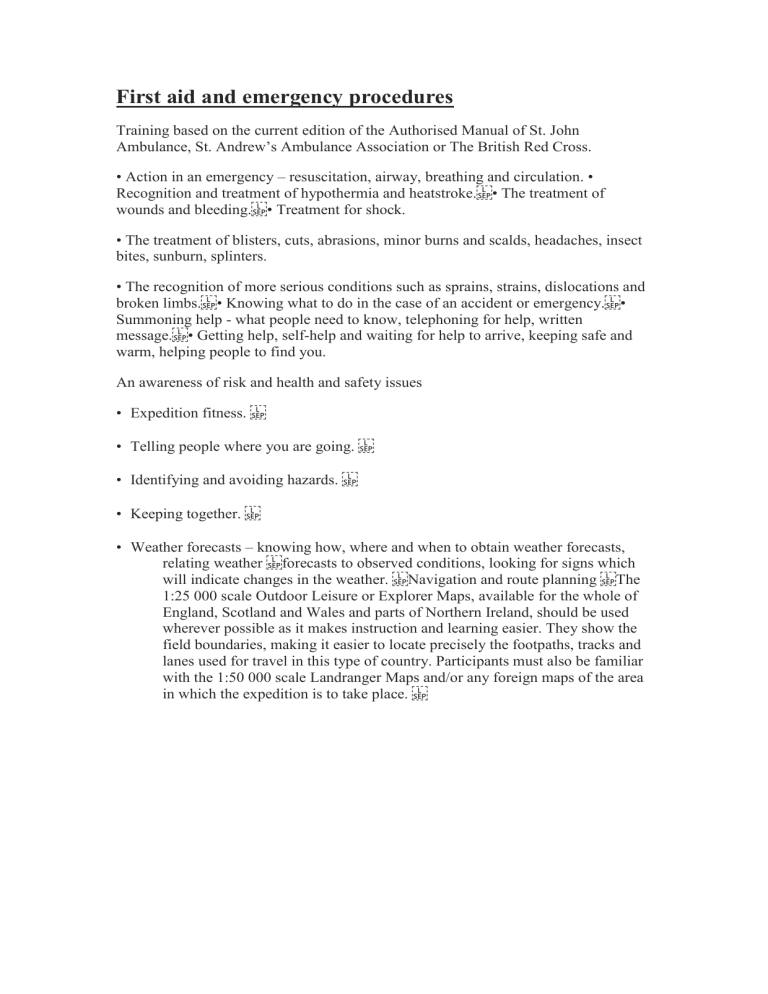
First aid and emergency procedures
Training based on the current edition of the Authorised Manual of St. John
Ambulance, St. Andrew’s Ambulance Association or The British Red Cross.
• Action in an emergency – resuscitation, airway, breathing and circulation. •
Recognition and treatment of hypothermia and heatstroke. • The treatment of wounds and bleeding. • Treatment for shock.
• The treatment of blisters, cuts, abrasions, minor burns and scalds, headaches, insect bites, sunburn, splinters.
• The recognition of more serious conditions such as sprains, strains, dislocations and broken limbs. • Knowing what to do in the case of an accident or emergency. •
Summoning help - what people need to know, telephoning for help, written message. • Getting help, self-help and waiting for help to arrive, keeping safe and warm, helping people to find you.
An awareness of risk and health and safety issues
• Expedition fitness.
• Telling people where you are going.
• Identifying and avoiding hazards.
• Keeping together.
• Weather forecasts – knowing how, where and when to obtain weather forecasts, relating weather forecasts to observed conditions, looking for signs which will indicate changes in the weather. Navigation and route planning The
1:25 000 scale Outdoor Leisure or Explorer Maps, available for the whole of
England, Scotland and Wales and parts of Northern Ireland, should be used wherever possible as it makes instruction and learning easier. They show the field boundaries, making it easier to locate precisely the footpaths, tracks and lanes used for travel in this type of country. Participants must also be familiar with the 1:50 000 scale Landranger Maps and/or any foreign maps of the area in which the expedition is to take place.
Preparatory map skills
• The nature of maps.
• Map direction.
• Scale and distance, measuring distance, distance and time.
• Conventional signs.
• Marginal information.
• Grid references.
• Understanding contours, recognition of major land forms such as hills, valleys, ridges, spurs.
• Interpretation of contours into mountain land forms and relief, slope and gradients and the determination of height.
• The ability to give a verbal description of a route linking two places from the map.
Practical map skills
• Setting the map.
• Relating the map to the ground.
• Locating position using the map.
• Determining geographical direction, and direction of travel from the map.
• Checking the direction of paths using the set map.
• Identifying and locating features in the country by using the map.
• Locating features marked on the map in the countryside.
• Relating the map and contours to the ground. Estimating journey times in wild country.
• Planning a route, preparing a route card. Estimating speed of travel and arrival times. (ETA estimated time of arrival.)
• Following a planned route.
• Navigation in restricted visibility. Action to be taken in the event of being lost
Compass skills
• The care of the compass.
• The influence of ferrous objects and electromagnetic fields.
• Magnetic variation and the relationship between True, Magnetic and Grid Norths.
• Directionfromthecompassintermsofthecardinalandintercardinalpoints.Measuringdirectionindegrees.
• Setting the map by the compass.
• Determining the direction of footpaths or direction of travel.
• Travelling on a bearing. Obtaining a grid bearing from the map, allowing for magnetic variation where appropriate.
• Practically all the understanding and techniques listed above are equally important for expeditions on land or on water, but instruction should be modified as necessary for water expeditions and charts substituted.
Campcraft, equipment and hygiene
• Choosing suitable clothing, footwear and emergency equipment and knowing how to use it.
• Choosing and caring for camping gear.
• Packing a rucksack, waterproofing the contents, always keeping the weight down to a minimum, and less than 20% of the body weight when walking.
• Choosing a camp site, arrangements for water, cooking and sanitation, refuse disposal, fire precautions.
• Pitching and striking tents. Food and cooking • Cooking and the use of stoves. • Safety procedures and precautions which must be observed when using stoves and handling fuels. • Follow the stove safety instructions. •
Cooking substantial meals under camp conditions. Countryside, Highway and Water Sports Safety Codes
• Understanding the spirit and content of the Countryside Code.
• The avoidance of noise and disturbance to rural communities.
• A thorough knowledge of the content of the Highway Code with special emphasis on specific modes of travel such as horse riding or cycling if they are to be utilised during the expedition.
• If undertaking a water based expedition, a thorough knowledge of the Water Sports
Safety Code.
